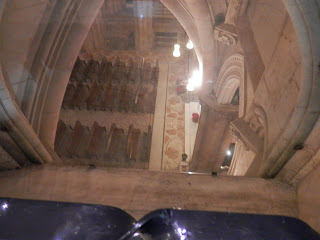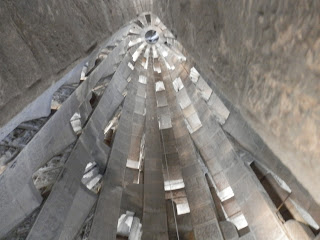Saturday, February 9, 2013
Eurotrip: Barcelona
I caught an evening flight from Alicante to Barcelona. Now I was travelling without a mobile and it was already proving to be a challenge and something that was teaching me lessons. Lenka and I made plans to meet up in Plaça Espanya. Lucky for me the airport bus stopped there. Unlucky for me I got there earlier then Lenka and I had planned and I couldn’t remember where I was supposed to meet her. So I walked around the square… well it was more of a huge round about and when I got back to the bus stop I hadn’t found Lenka so I felt a bit frightened because I hadn’t had wifi since I left Ana’s so I couldn’t face book Lenka to get her address or anything. So I stopped for a minute and took a deep breath gave myself a pep talk and then walked back around and there she was!
We chatted on our walk back to her flat. It was a nice walk and she lived on a street that was super easy to find since thank goodness it was on the map. The first night we didn’t stay up like we were Spanish because Lenka had work the next day and I was tired from spending the evening in the airport.
The next day I slept in a tiny bit before heading out to see the sites!
I started by walking back through Plaça Espanya
And on to Font Montjuic, which since it’s winter is only on during the weekend for a short time. But that cool castle thingy is Museu Nacional D’art de Catalunya.
Oh I forgot to mention that in Barcelona since they are in Catalonia they speak a different type of Spanish in case you didn’t notice that Plaza de España is Plaça Espanya…. Weird right? And here I was just getting into the grove of Spain Spanish. So needless to say I was thrown off by some of the names since last time I backpacked Spain I had no problem navigating or understanding what I was seeing since the map was readable. Now it just took a moment or two longer to decided what I was seeing.
I made my way down to Mirador de Colom
From there I headed up La Rambla to find the cathedral. Turns out I got lost in the gothic section for a while.
I did find the cathedral
And a cool store where I bought myself and my brother’s girlfriend presents. Then I got lost again and was under the impression I was heading towards Font de Canaletes but turns out I ended up back at Mirador de Colom. So I took a seat on the harbour steps and ate lunch before planning a different route. I walked along the waterside
And made it to Parc de la Ciutadella.
I saw the Parlament de Catalunya
This is a replica of Josep Llimona’s beautiful sculpture "El desconsol" (Distress).
Hmmm well upon further research the description of this says it’s a man… I was totally under the impression this was a chick! On stay.com I found that this sculpture is an “early 20th century representation of modernisme, the Catalan home-grown art movement.”
Then there’s a mammoth stone statue there… I did a little research, so correct me if I’m wrong, but this mammoth has little significance other then it was based off a sketch by some famous old dead dude. I was hoping for something cooler, like they found a mammoth skeleton in Barcelona… that’s a long shot I guess.
From the mammoth I wandered to the Cascada. It was built in 1888 for the Universal Exhibition of Barcelona. La Cascada was designed by designed by Josep Fontsère, assisted by Antoni Gaudí. Apparently it’s loosely based on the Trevi Fountain in Rome.
I walked out of the part and decided since it was mid afternoon I should finally strike out towards Sagrada Familia. But first I wanted a picture of Torre Agbar since apparently it’s something important.
Then I walked by the Plaça de Toros Monumental..
And onto the basilica!
Now let me give you a run down of the basilica and it’s architect. All my info is coming from the Sagrada Familia site.
I don’t know about you but when I think of the cathedrals and basilicas in Europe I think of these old churches like Saint Peters or Notre Dame. Well Sagrada Familia is old but not finished. The foundation stone was laid on the 19th of March in 1882. The crypt was the first thing to be started and that was when Francisco de Paula del Villar y Lozano was the architect. Not long after the start of the project there was a disagreement and the commission was handed over to Antoni Gaudí. I don’t know if you’ve ever heard of Gaudí but he’s kind of a big deal. He designed a number of buildings in Barcelona.
Originally Sagrada Familia was supposed to be a neo-Gothic style church but when Gaudí got a huge anonymous donation he rethought the design into what it is today. He designed everything to have major meanings and to explain the teachings of the Gospels and the Church. The construction of the Nativity façade began in 1892 and was finished in 1899.
In the early years of the construction Gaudí worked on other projects as well but starting in 1914 he worked exclusively on Sagrada Familia. He was so dedicated that the last few months of his life next door to his workshop. This room was actually beside the apse and had been used for making scale models, doing sketches and drawings, as a sculpture studio and a space for photographic work.
November 30th 1925 the 100 meter high bell tower on the Nativity Façade was completed and this would be the only one Gaudí lived to see completed, since on 10 June 1926 he died as a result of a tragic accident three days earlier, when he was run over by a tram. On 12 June he was buried in the Carmen Chapel in the crypt of La Sagrada Família, where his remains still lie today. It’s interesting because you can look down into the crypt but nothing tells you that it’s where Gaudí is buried, I had to do my research to figure out what it was.
After Gaudí’s death the work passed to his close associate and then to a few others that had worked closely with him. And the work continued till July 1936 and the outbreak of the Spanish Civil War. Revolutionaries set fire to the crypt and destroyed the workshop. This means all the original plans, drawings, and photos were lost and the plaster models were smashed. This put the work on hold till 1939. From 1939 to 1940 an associates of Gaudí’s restored the crypt and remade the broken and damaged models and these are what have been used to continue the work according to Gaudí’s original idea.
In 1954 the foundations for the Passion façade were laid. In 1958 the sculpture of the Holy Family was placed in the Nativity façade. In 1976 the four bell towers were started and completed the following year. From 1978 the foundations of the nave and the crossing were done and the columns, vaults and façades of the main nave and the transepts were erected.
In 2000 the vaults of the central nave and the transept were built and work began on the foundations of the Glory façade. In 2001 the central window of the Passion façade was completed with the installation of a stained glass window. The vaults of the ambulatory of the apse were finished in 2008. Between 2008 and 2010 the vaults of the crossing and the apse were completed. The church will be complemented with the construction of the main façade, the Glory façade.
It’s crazy to think that after 131 years it’s still under construction! A way they raise money is by ticket sales for seeing the basilica. When I went I paid 3€ extra to climb one of the bell towers. Now let me tell you about this little adventure I went on. You take the lift up 50 meters and walk up another 10 for a total of being 60 meters up. The views of Barcelona were amazing! Then you get to walk down. So I walked all the way down and tried to open the door but it was stuck tight. So I hiked my arse all the way back up and to the lift only to find a whole group of people who had the same problem as me. We all got to take the lift back down and the lady on the lift was like turns out the door was just jammed, you should have pushed harder. I got a work out and a half from climbing up those stairs, my legs were mega sore the next few days.
Now without boring you any more here are my pictures of La Sagrada Família.
My last stop of the day was another of Gaudí’s creations, Casa Batlló. This building was restored by Gaudí and Josep Maria Jujo from 1904 to 1906 and was originally redesigned for a middle class family. Damn, if I had a house like that I would love it! It looks really cool on the outside. Since it’s an art museum and expensive to get in I didn’t. But thanks to google I’ve seen some pictures of what it looks like and it’s a really whimsical house. I’d tots def live there.
After Casa Batlló I made my way back to Lenka’s flat to have dinner before getting ready to go out for the night. One of her old flatmates was getting ready to leave home that week so there was a sort of going away party that we went to.
I caught 3 hours of sleep before leaving the warm Spanish weather behind for Budapest.
Cheers,
Labels:
Barcelona,
Europe,
Eurotrip 2013,
pictures,
Sagrada Familia,
Spain
Subscribe to:
Post Comments (Atom)



















































































No comments:
Post a Comment